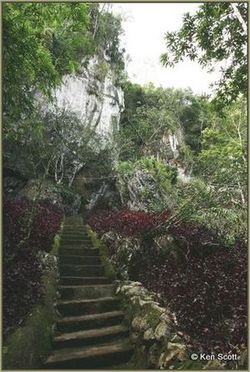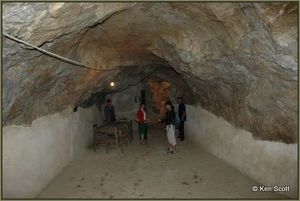A new audio tour in Laos, Indochina helps tourists understand the real and terrible story of America's 'secret war' in the region. By Ken Scott.
Viengxay, Laos, 1 March 2011. Between 1964 and 1973 America secretly more bombs on neighbouring Laos, a scenic mix of abrupt limestone mountains and green valleys with rice paddies and hamlets, than were dropped on Europe in the whole of World War II. Worse still, it was not officially at war with the country.
The Viengxay hospital built outside the cave complex
Despite the rain of death, over 20,000 people in Viengxay in northeast Laos survived by living in an elaborate network of caves in the hills, complete with a hospital, bakery, school, shop, theatre and government offices as well as ordinary living quarters.
A new audio tour of the caves, produced by a Sydney-based company, is now available to tourists visiting Viengxay, and calls on the recollections of nearly 50 survivors who were interviewed for the audio tour. People who told their stories included farmers, doctors, soldiers, nurses, and mothers who gave birth in the caves.
The caves were only accessible through strengthened doorways like this one
This is the first time a large number of eye witnesses have been tracked down and their testament uniquely recorded for posterity and future use by historians. "We would shout at the planes flying overhead, 'Why are you doing this to us? Why are you trying to destroy us?'" recalls Ms Pengsi Sommany, who was part of the Xieng Xeu village defence unit during the war.
Some of the access stairs are now bordered by flowers, contradicting the violent history of the place
Drama
Penny Street, Director and Founder of Narrowcasters – the company that produced the audio tour - recalls how she was taken aback by the site, its extraordinary history, remoteness and ruggedness. "What struck me most was the drama and significance of this unknown David and Goliath story – and the forgiving nature of the Lao people,” she said.
In the audio tour, survivors recall how for nine years under guidance from the Pathet Lao resistance, they built shelters in the mountain caves, worked the bomb-strewn fields and defended themselves in their grottoes and forest retreats as the earth shook around them.
The audio tour pays homage to the villagers of Viengxay. "Having survived the years of bombardment, I and other witnesses in the recordings describe what it was like," says Mr Siphan Vangdeuayang, Director of the Kaysone Phomvihane Memorial Cave Office in Viengxay. "We remember our family members, friends and colleagues who did not live to tell their own stories."
Still Killing
The tour covers events from late 1950s to the end of the bombing raids in 1973, and also explains the legacy of unexploded war bombs in the fields of Laos today. The Laotian government says unexploded ordnance kills about one person a day in Laos, with many of the casualties being innocent farmers, or their children playing in the fields.
The massive cave complex includes offices, surgeries, a theatre and eating and sleeping quarters
Despite its rugged beauty, Viengxay still receives very few tourists due to difficulty of access. However, flights are now available on 18-seater planes from the Laos capital, Vientiane, three times a week to Xam Nua, a 45 minute drive from Viengxay. The nearest airport with daily flights from Vientiane is Xieng Khouang, a six-hour drive from Viengxay.
However, an increasing number of travellers have been finding their way to Viengxay from both Luang Prabang and Xieng Khouang on Laos' public bus system. Some tourists prefer to be driven in from the Vietnamese border, 55 kms away. Visas on arrival are now available at Nam Meo, the nearest Vietnam border point to Viengxay.
Photos courtesy Ken Scott/Narrowcasters



